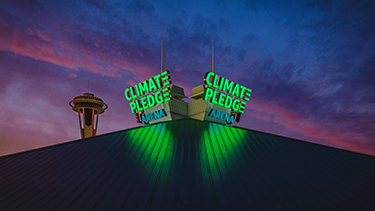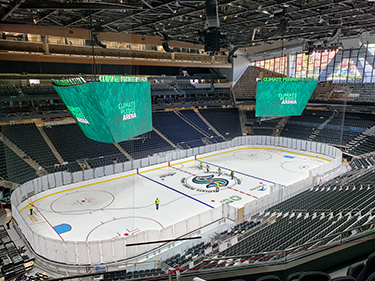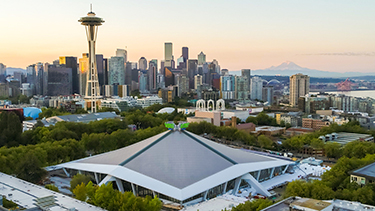|
Subscribe / Renew |
|
|
Contact Us |
|
| ► Subscribe to our Free Weekly Newsletter | |
| home | Welcome, sign in or click here to subscribe. | login |
Construction
| |
 |
October 28, 2021
Setting new marks for sustainability, innovation, fan experience
Populous

Cheong
|
The team from global design firm Populous was approached with this challenge: Take Seattle’s historic 1960s Century 21 Coliseum, a registered landmark locally and federally, and transform it into the industry’s leading sports and live entertainment arena.
Here’s what that involved: Fit a 17,000-seat seating bowl under the historic roof (which sits only 20 feet above the ground at the corners) and place it within the compact 360-foot-square footprint of the original building; attract the highest profile corporate sponsors and brands from the Pacific Northwest; infuse the experience with the latest technology and digital displays, both inside and outside; design it to be the most sustainable arena in the world; design it to be authentically Seattle; and get all this approved by both the local and federal landmarks boards.
Easy, right? Well, the odds were stacked against us, but last week, Populous’ newest designed arena was unveiled to the world.
Climate Pledge Arena is a transformational project and one of the most significant private investments in Pacific Northwest sports and entertainment history. As architect of record, Populous was engaged by owner and developer Oak View Group and the city of Seattle to transform the former Coliseum (more recently KeyArena) into an entirely new live entertainment experience boasting industry-leading innovation, sustainability and fan experience.
Located in Seattle’s Uptown neighborhood and on the western edge of Seattle Center, the arena serves as the home venue for the National Hockey League’s Seattle Kraken and the Women’s National Basketball Association’s Seattle Storm. A multifunctional venue by design, Climate Pledge Arena will also host many concerts and other events year-round, with a seating capacity for up to 18,600.
Climate Pledge Arena offers many “firsts” and unique aspects. The arena’s moniker enlists the facility in The Climate Pledge, committing signatories to net zero carbon across their businesses by 2040. Climate Pledge Arena is also poised to become the world’s first International Living Future Institute-certified zero carbon arena.
A major challenge throughout construction was preservation of the 59-year-old historic roof atop the former KeyArena. All new construction required the roof — designed by Paul Thiry, the father of architectural modernism in the Pacific Northwest — be temporarily suspended above the site. To increase the size of the arena to 750,000 square feet — approximately twice the size of the former venue — and give the venue 360-degree pedestrian access, it was necessary to dig 16 feet deeper than the previous 1995 renovation that bottomed out at 38 feet below ground level, and significantly expand the below-grade building footprint in all directions.
Populous’ design centered around revitalizing the landmark arena, honoring its original 1960s design intent while activating and enhancing a pedestrian-focused plan. The original building was a flat-floor, column-free pavilion with an entirely glass facade allowing visitors to see inside. Populous’ redesign for Climate Pledge Arena preserves the character-defining features of the original building, including the glass curtainwalls, roof and roof support structure, and restores the original relationship between building and surrounding plazas that was altered in the prior KeyArena renovation.
The historic glass curtainwall was disassembled, catalogued and stored during construction. After the original lead paint was abated, the curtainwall steel frames were refinished, then reassembled to match the historic condition. On the arena’s north end, the curtainwall engages the seating bowl, celebrating views to the north plaza through this historic cathedral window, and blurring the boundary between interior and exterior.
At street level, containing the new arena under the existing roof and within the historic curtainwalls allows the site to be transformed into a 360-degree urban pedestrian park in the heart of the city. The site is universally accessible throughout and has no operational “back door,” vastly improving on the previous condition and promoting a new green gateway into Seattle Center from the west.
Sixty-seven mature London Plane trees that also hold landmark status from the 1962 World’s Fair have been preserved around the perimeter of the site. The trees maintain a massive canopy and connect the dense neighborhood to the expansive Seattle Center campus with a broad, shaded pedestrian corridor. They also provide a visual buffer along the edges of the site, allowing the expansive historic roof to sit humbly within the Uptown neighborhood.
Climate Pledge Arena certainly lives up to its name, setting a new standard for sustainable design and operations. There will be no fossil fuel consumption in the arena for daily use. All facility mechanical, heating, dehumidification and cooking systems were converted to all-electric systems. A “rainwater-to-ice” system has been implemented to harvest Seattle rainwater from the historic roof, collect it in an underground cistern, then purify it for use in ice resurfacing machines to create the “greenest ice” in the NHL. Solar panels are integrated on the new entry atrium and adjacent existing parking garage, and these combined with off-site renewable energy sources will help the venue achieve its zero-carbon certification.
Unlike any other arena video display, Climate Pledge Arena features the industry’s first dual suspended scoreboards. Behind this new design lies a thorough analysis of on-ice and on-court action for hockey and basketball, spectator and athlete sightlines, and flexibility for shows and concerts. The result is a pair of distinctly shaped video displays that places video content in an ideal location for spectators and improves the atmosphere and connection between fans on opposite sides of the seating bowl. Setting this forward-thinking design innovation under the historic roof honors the legacy of the building, which was to showcase futuristic ideas and exhibits as part of the “World of Tomorrow” theme of the World’s Fair.
Together, alongside our partners at Oak View Group and the city of Seattle, we have created the world’s best live entertainment building. By marrying an intentional process of preserving and celebrating an iconic Seattle landmark with industry-leading venue design, Climate Pledge Arena is the new benchmark.
Geoff Cheong is an architect and principal at Populous, and served as lead project designer for Climate Pledge Arena.
Other Stories:
- Transforming Seattle’s historic KeyArena
- What it took to build the ‘greenest’ arena ever
- Reimagined precinct brings back World’s Fair magic





